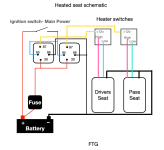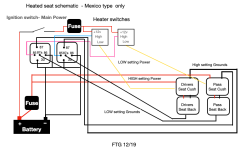Here is a quick schematic --- I just finished a car like this
the relays are standard configuration for Hella/Bosch relays
85 energizes the relay only when the "main power" switch is closed (on)
30 is hot all the time but fused and will not draw power with ignition off. Alternating 30 goes to main power cut off switch
NOTE:Some heater switches have an indicator light and may need a ground wire as well to make the LED work
Also some seat heaters only have one "hot" going to them and the "switch" does the High/low switching
but the idea is the same - German heaters always have two wires high and low, China have just one wire plus ground
View attachment 4528



